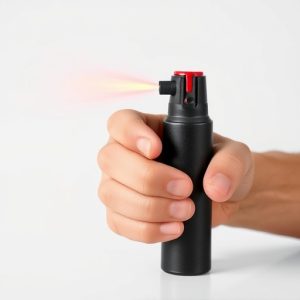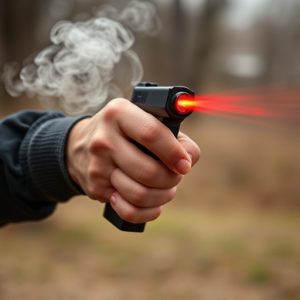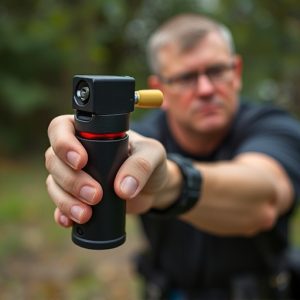Unveiling the Science & Legalities of Strongest Legal Pepper Spray Ingredients
The strongest legal pepper spray ingredients, such as capsaicin from chili peppers and synthetic alt…….
The strongest legal pepper spray ingredients, such as capsaicin from chili peppers and synthetic alternatives like olvanil, are crucial components in personal protection devices. These compounds target nerve endings, causing intense irritation and temporarily incapacitating assailants, offering vital seconds to escape or seek help. Their effectiveness and legality vary by region, with strict regulations on concentration levels, ensuring users have access to safe yet potent self-defense solutions tailored to their needs.
“Personal protection devices, such as pepper spray, have become essential tools for self-defense. Understanding the science behind chemical irritants, specifically the strongest legal pepper spray ingredients, is crucial. This article delves into the effectiveness and safety of various chemicals used in these devices. We explore the science behind key ingredients, legal considerations, and the importance of understanding what makes a pepper spray truly potent. By shedding light on these factors, we aim to empower users to make informed decisions.”
- Understanding Chemical Irritants for Personal Protection Devices
- The Science Behind Pepper Spray Ingredients
- Legal Considerations and Strongest Pepper Spray Components
- Safety and Effectiveness of Commonly Used Chemical Irritants
Understanding Chemical Irritants for Personal Protection Devices
Chemical irritants play a pivotal role in personal protection devices, particularly pepper spray, ensuring users have an effective means to deter and defend against potential threats. Understanding these irritants is key to creating robust and reliable self-defense tools. The most potent legal pepper spray ingredients are derived from natural sources, with capsaicinoids, the active compounds found in chili peppers, being the primary focus. These compounds stimulate nerve endings, causing intense irritation and temporary incapacitation of the target.
Amongst the strongest capsaicinoids used in personal protection devices are oleoresin capsicum (OC) and capsaicin. OC is a potent extract from chili peppers, offering a broader spectrum of protection against various threats. Capsaicin, the primary irritant in pepper spray, directly activates nerve receptors, leading to a rapid response and discomfort for the assailant. The legal status and availability of these ingredients vary by region, ensuring users have access to effective yet compliant self-defense solutions.
The Science Behind Pepper Spray Ingredients
The effectiveness of pepper spray lies in its unique active ingredients, carefully formulated to cause irritation and temporarily incapacitate an aggressor. The strongest legal pepper spray ingredients typically include capsaicin, a compound derived from chili peppers, and various other chemicals like oleoresin capsicum (OC). These substances are known for their ability to bind with pain-signaling neurons in the body, leading to intense discomfort, teary eyes, and difficulty breathing.
Capsaicin, in particular, is renowned for its potency, often used in research to induce pain responses. When incorporated into pepper spray, it acts as a powerful irritant, ensuring that users can defend themselves against potential threats. The precise formulations vary among brands, but each aims to provide the best protection while adhering to legal restrictions on the use of such chemical compounds.
Legal Considerations and Strongest Pepper Spray Components
In many jurisdictions, the development and deployment of chemical irritants for personal protection devices like pepper spray are subject to stringent legal regulations. Authorities carefully scrutinize the active ingredients to ensure they meet safety standards and pose minimal risk to bystanders while maintaining effectiveness against potential threats. The strongest legal pepper spray ingredients are those that exhibit potent yet controllable properties, often derived from natural sources or synthetic compounds designed to specifically target nerve endings without causing permanent harm.
Among the key components considered for legal use in pepper spray are capsaicin, olvanil, and various other chemicals known for their irritant properties. Capsaicin, found in chili peppers, is a widely used ingredient due to its high potency and relative safety profile when formulated correctly. Olvanil, a synthetic alternative, offers similar effectiveness but with a faster onset of action, making it appealing for tactical applications. The selection of the strongest legal pepper spray ingredients involves a delicate balance between maximizing protection and adhering to regulatory guidelines, ultimately ensuring that personal protection devices remain effective tools for self-defense without causing unnecessary harm.
Safety and Effectiveness of Commonly Used Chemical Irritants
In the realm of personal protection devices, chemical irritants play a pivotal role in deterring potential threats. Among the commonly used substances, pepper spray stands out for its effectiveness against aggressive dogs, rioters, and muggers. The strongest legal pepper spray ingredients often include capsaicin, a compound derived from chili peppers, which can cause severe irritation and temporary blindness at high concentrations. This irritant’s safety and legality are well-documented, making it a preferred choice for self-defense devices used by law enforcement and civilians alike.
The effectiveness of these chemical irritants lies in their ability to disrupt vision and breathing patterns, providing crucial seconds for escape or intervention. While not harmful in the long term, the intense irritation can incapacitate an attacker temporarily. It’s essential to note that the potency and legality of pepper spray ingredients vary by region, with some countries and states having strict regulations on the concentration levels allowed for civilian use. The strongest legal pepper spray formulations balance efficacy against safety, ensuring they pose minimal risk to users while offering robust protection.
In conclusion, understanding chemical irritants and their science is key to developing effective personal protection devices. The strongest legal pepper spray ingredients, like capsaicin and CS gas, have been extensively studied for their safety and effectiveness in deterring attacks. However, it’s crucial to balance potency with responsible use, ensuring these devices serve as a last resort for self-defense while adhering to legal guidelines.


